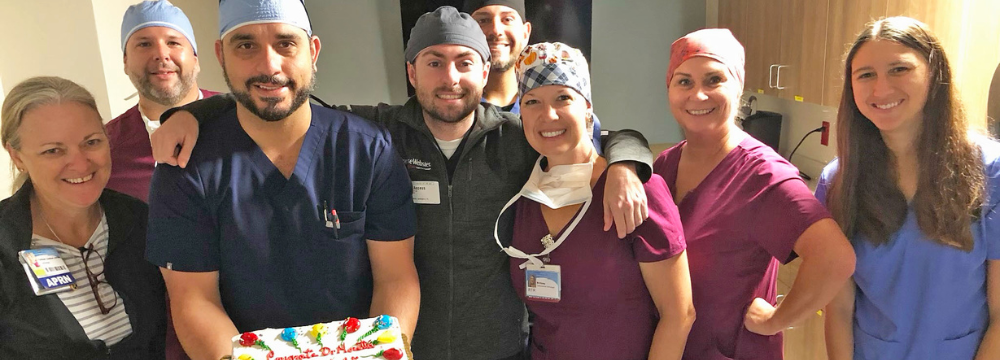Dr. Moretta Performs the 100th Ablation on a REAL-AF Study Participant
Dr. Moretta and our team here at Sarasota Memorial Hospital are very excited to be a part of an important, ongoing study known as REAL-AF. In conjunction with our partners at Biosense Webster, a leader in catheter ablation technology, the study aims to follow 8000 patients from pre-ablation through one-year post-procedure. The goal is to understand the outcomes of radiofrequency catheter ablation more clearly and to understand its consequences, effectiveness, and safety.
RF ablation is the procedure where we apply heat to destroy malfunctioning heart tissue, and we usually employ it if lifestyle changes and medications have not been suitable or effective. In the image you see below, Dr. Moretta performed the 100th ablation as part of the study on a patient suffering from paroxysmal Afib, which means that it randomly comes and goes. This is usually the earliest manifestation of Afib and the best time to treat it. If left untreated, it can develop into persistent Afib, for which treatment is less predictable.

The image below shows a 3-D rendering of the heart using advanced Carto mapping technology developed by Biosense. This gives us an excellent view of the heart’s structures and what we need to treat. A normally functioning heart would be entirely purple on this map, showing that the heart’s electrical signals are consistent. However, the variance in color shows us that an arrhythmia is indeed present and allows us to identify treatment areas. Since it is a real-time visual of the heart’s electrical signals, we can also tell immediately if our strategy targeted the appropriate areas. You’ll also notice red dots that look like bracelets around blood vessels. The standard of care for most ablations is to treat the area around the pulmonary veins, known as Pulmonary Vein Isolation or PVI.

A Little More About the REAL-AF Study
As mentioned, the REAL-AF study aims to enroll about 8,000 patients across various ablation centers throughout the United States. First, we take a pre-ablation or baseline assessment of the patient’s arrhythmia. This gives us a great starting point to understand the procedure’s effectiveness. Also, arrhythmias show up differently in many patients, and we’ll be looking to see if ablation is more or less effective in patients with specific manifestations. Once the ablation is performed, we will follow up with the patient at 10 to 12 weeks, six months, and one year. This will help us understand if there are any acute or longer-term complications while tracking the patient’s progress.
The Importance of This Study
While we have plenty of clinical data on the effectiveness of cardiac catheter ablation, this is one of the more comprehensive and well-formed studies to date. Taking what we already know about catheter ablation and adding these results will help us to better understand which patients are best served with an ablation versus other arrhythmia interventions. It can also help regulatory bodies and physicians develop pre-and post-operative care guidelines.
A Little More About Our 100th Patient
Our 100th patient was a man in his 60s, suffering from occasional Afib. The treatment plan was relatively straightforward, and we were able to keep the procedure time down to 45 minutes which is a hallmark of our work. We have worked hard to leverage the incredible technology and advancements in electrophysiology to reduce procedure time not only for the patient’s comfort and convenience but also to minimize anesthesia time and get them back on their feet for a swifter recovery. This patient was discharged home before lunchtime on the day of the procedure.
Another hallmark of our offering is, whenever possible (and now, most of the time) we avoid using fluoroscopy or continuous X-ray to guide the catheter. This procedure was performed using advanced ultrasound technology, posing no risk to the patient and saving them significant radiation exposure that is cumulative over a lifetime.
We expect this study to continue for another year, at which point we will have concrete data to evaluate and present. As always, we encourage you, if you haven’t already, to get Afib treated at its earliest symptoms to avoid potential problems down the road. Dr. Moretta and our entire team approach each patient’s care in a stepwise manner, intending to give the patient options and the hope of a straightforward and successful procedure.
Contact us to learn more about Afib ablation and our program. We look forward to helping you address any arrhythmia issues you have